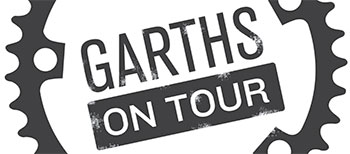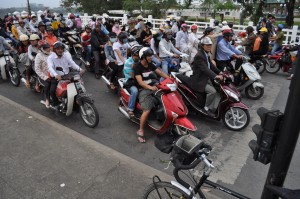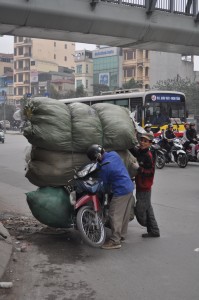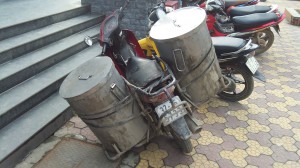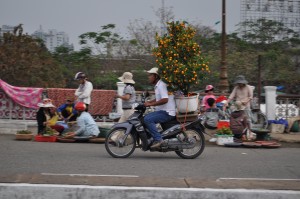People had warned us before we came, and one simple fact became clear as soon as we crossed the border from China. There are A LOT of motorcycles in Vietnam. In fact, motorbikes and scooters make up 95 percent of registered vehicles in this country. Right away I noticed the absence of regular cars.
Now, it might seem that this would create a better environment for cycling… but I would say it creates a better environment for chaos. But to be fair, there’s never a road where motorcycles or bicycles are completely banned–there’s always a wider shoulder or a separate bridge when necessary, so it’s not without its perks.
On our second day in Hanoi, I had my first incident with a motorbike. As we were making a left turn, I heard Dave yelling from behind me, and before I knew it, I was being grazed by a moto that was cutting between me and the stopped car on my left. I didn’t fall to the ground, fortunately, but it was certainly enough to knock me off of my bike. I was stunned for a moment, slightly bruised, trying to situate my water bottles back in their place and readjust my ride… meanwhile, traffic tried to move on. It was not one full second before honking commenced at full volume, and it didn’t stop until I finally got my act together and got moving again.
Later that night, I shared with Quynh, our warmshowers host, that I had been hit by a motorcycle that day.
“I will need to explain to you the rules of circulation,” he replied matter-of-factly.
“Oh really?” Hmmm… there are RULES here? I don’t know about that–seems like general chaos to me, I thought. But that night on our way to dinner, Quynh offered some basic teaching on traffic in Hanoi.
“There are two rules,” he started. “The first is to not hit anyone.” OK… seems straightforward enough. He continued, “The second is not be hit.”
Fail–I had already violated one of the rules.
He went on to explain the philosophy behind much of the motorcycle driving. He said that people don’t like to change speed, because it requires them to change gears, which wears their gears out, and replacing them is expensive. Also, people avoid using their brakes, because using the brakes wears them out, and replacing them is expensive. I was beginning to sense a pattern.
Although Quynh’s teaching was somewhat instructive, I think the best way to learn to handle traffic in Vietnam is to face it head on. So, after three weeks of navigating these crazy streets, we have formulated this instruction manual for anyone back home who would like to come to Vietnam and blend in with the locals while driving a motorcycle.
INSTRUCTION MANUAL FOR DRIVING A MOTORCYCLE IN VIETNAM
We’ll begin with the assumption that you already have a motorbike. After all, you’re in Vietnam.
1. Horn
The first thing you’ll want to do is test the horn. That’s right–your bike is absolutely useless without a horn, preferably one that is disproportionately loud to the size of the bike itself. If it doesn’t already have a horn, you’ll need to buy one from a street vendor… maybe a two-toned version? The sky is the limit, but be SURE it works! You’ll be using it plenty.
2. Loading up
Why are you even taking your motorcycle anywhere unless you have it loaded up with stuff or other people? Obviously just riding your motorbike alone and without cargo is an inefficient use of it. You’re going to want to attach, tie on or strap down some kind of load, or bring along two or more family members or friends.
3. Use a mask.
The helmet is important, yes, and there are helmet laws here in Vietnam. But perhaps even more important is the classic Asian mask. This clever invention will help protect you from inhaling exhaust in the city and dust that often fills the countryside air.

Dave proudly models our recent gear addition: the mask. We were quite proud of our decision to blend in with the locals.
4. On the Road
Now that your horn is functional, you’ve loaded up, and you’re wearing your mask, we should go over the actual rules of the road. We’ll address some critical issues such as pulling out, passing through an intersection, and navigating one-way streets.
Pulling out: When pulling out into traffic in Vietnam, your strategy is quite simple. As you approach the road, make sure to honk your horn a few times. Then, no worries about checking to see if anyone is coming–they will see you and adjust their course. Don’t stop, don’t pause, don’t look–just pull right into the action.
Passing through an intersection: As you approach the intersection on your motorcycle, you will want to be sure to honk the horn a few times. Then, though you might slow down a bit, don’t worry about stopping, just pull through the intersection. Those other people that might be coming will surely see you and adjust their course.
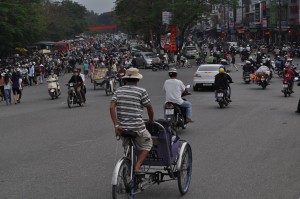
Note there is a lone car in this picture, along with this not-so-uncommon bicycle taxi. Everything else? Motorcycles.
Navigating one-way streets: Rules like “one-way streets” can be loosely interpreted, especially on a motorbike. That one-way sign doesn’t really apply to you, only to cars. So, don’t worry about it. Go right down that street and don’t worry about any oncoming traffic–surely they will see you and adjust their course.
Now that you understand the basic principles of motorcycle navigation, you are ready to join the fun and hit the streets in Vietnam!
